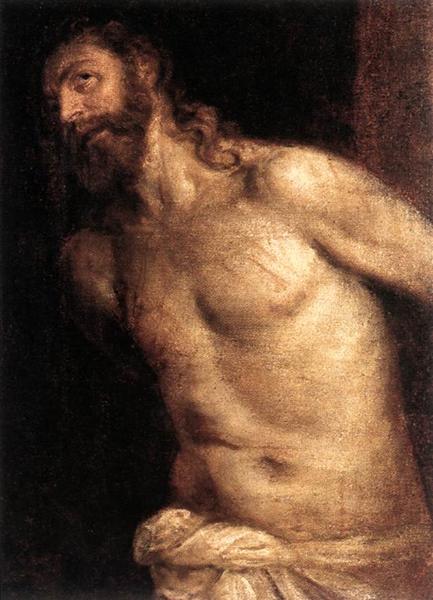Beschrijving
The Flagellation of Christ, painted by Titian in 1560, is a work that encapsulates the Venetian artist’s mastery in the representation of tragedy and human suffering. In this work, Titian addresses a deeply emotional and religious subject, placing Christ at the centre of the composition, subjected to the violence of his executioners, an iconic moment of the New Testament. The choice of this momentous episode reflects both Titian’s interest in spirituality and his ability to represent the human experience in all its complexity.
The arrangement of the figures in the work is masterful. Christ is in a pose that denotes both his suffering and his dignity. His posture, with his arms bound and his gaze serene despite the pain, resonates with the classical figure of the martyr, caught between torment and redemption. The executioners, who surround the Savior, are portrayed with an emotional intensity that contrasts sharply with Christ’s calm. Titian employs a dynamic use of space that channels the viewer’s attention to the suffering of the central figure while capturing the brutality of the act being carried out. This ethereal interplay between pain and serenity allows the work to transcend mere historical account, providing a meditation on sacrifice.
Color is another of the tools that Titian masterfully uses in this work. The palette is made up of saturated and vibrant tones that capture light and shadow, giving additional drama to the scene. The deep reds and browns of the background contrast with the white and blue of Christ's clothing, directing the viewer's gaze towards the protagonist in an almost instinctive movement. This contrasting technique not only accentuates Christ's suffering, but also brings the scene to life, creating an atmosphere charged with emotional tension.
In a broader analysis, The Flagellation of Christ aligns itself with the late Renaissance, a period that sought to express a deep humanism. While Titian is known for his use of color and light, the work is also strongly influenced by Mannerism, particularly in the elongation of some figures and the complexity of the composition. Through his work, Titian stands at the intersection of the High Renaissance and early Mannerism, establishing new ways of exploring visual narrative and the representation of the human body.
The work also invites us to reflect on the relationship between art and divinity. In the context of the Counter-Reformation, Titian uses this representation of Christ's suffering not only as a symbol of pain, but as a call to compassion and redemption. The aesthetic beauty, combined with the suffering evoked, creates a profound spiritual experience in the viewer, who is reminded of the sacredness of Christ's sacrifice.
In conclusion, The Flagellation of Christ is more than a depiction of physical torment; it is a study of human vulnerability and strength in adversity. Titian, with his unparalleled technical skill and ability to fuse form, color, and emotion, has created a work that not only illustrates a dramatic moment of passion, but also invites contemplation of suffering and hope. The richness of the painting resonates even today, making it one of the most enduring and moving contributions to the legacy of Renaissance art.
KUADROS ©, a famous painting on your wall.
Hand-made oil painting reproductions, with the quality of professional artists and the distinctive seal of KUADROS ©.
Painting reproduction service with satisfaction guarantee. If you are not completely satisfied with the replica of your painting, we will refund 100% of your money.

